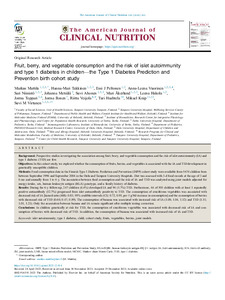Fruit, berry, and vegetable consumption and the risk of islet autoimmunity and type 1 diabetes in children : the Type 1 Diabetes Prediction and Prevention birth cohort study
Mattila, Markus; Takkinen, Hanna-Mari; Peltonen, Essi J.; Vuorinen, Anna-Leena; Niinistö, Sari; Metsälä, Johanna; Ahonen, Suvi; Åkerlund, Mari; Hakola, Leena; Toppari, Jorma; Ilonen, Jorma; Veijola, Riitta; Haahtela, Tari; Knip, Mikael; Virtanen, Suvi M. (2023-12-23)
Mattila, Markus
Takkinen, Hanna-Mari
Peltonen, Essi J.
Vuorinen, Anna-Leena
Niinistö, Sari
Metsälä, Johanna
Ahonen, Suvi
Åkerlund, Mari
Hakola, Leena
Toppari, Jorma
Ilonen, Jorma
Veijola, Riitta
Haahtela, Tari
Knip, Mikael
Virtanen, Suvi M.
23.12.2023
American Journal of Clinical Nutrition
Julkaisun pysyvä osoite on
https://urn.fi/URN:NBN:fi:tuni-202401221689
https://urn.fi/URN:NBN:fi:tuni-202401221689
Kuvaus
Peer reviewed
Tiivistelmä
Background: Prospective studies investigating the association among fruit, berry, and vegetable consumption and the risk of islet autoimmunity (IA) and type 1 diabetes (T1D) are few. Objectives: In this cohort study, we explored whether the consumption of fruits, berries, and vegetables is associated with the IA and T1D development in genetically susceptible children. Methods: Food consumption data in the Finnish Type 1 Diabetes Prediction and Prevention (DIPP) cohort study were available from 5674 children born between September 1996 and September 2004 in the Oulu and Tampere University Hospitals. Diet was assessed with 3-d food records at the age of 3 and 6 mo and annually from 1 to 6 y. The association between food consumption and the risk of IA and T1D was analyzed using joint models adjusted for energy intake, sex, human leukocyte antigen (HLA) genotype, and a family history of diabetes. Results: During the 6-y follow-up, 247 children (4.4%) developed IA and 94 (1.7%) T1D. Furthermore, 64 of 505 children with at least 1 repeatedly positive autoantibody (12.7%) progressed from islet autoantibody positivity to T1D. The consumption of cruciferous vegetables was associated with decreased risk of IA [hazard ratio (HR): 0.83; 95% credible intervals (CI): 0.72, 0.95, per 1 g/MJ increase in consumption] and the consumption of berries with decreased risk of T1D (0.60; 0.47, 0.89). The consumption of banana was associated with increased risk of IA (1.08; 1.04, 1.12) and T1D (1.11; 1.01, 1.21). Only the association between banana and IA remain significant after multiple testing correction. Conclusions: In children genetically at risk for T1D, the consumption of cruciferous vegetables was associated with decreased risk of IA and consumption of berries with decreased risk of T1D. In addition, the consumption of banana was associated with increased risk of IA and T1D.
Kokoelmat
- TUNICRIS-julkaisut [17009]
